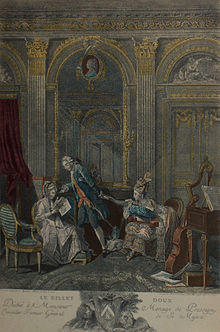Billet doux
In the 17th, 18th and 19th centuries, the billet doux ( French billet doux 'love letter', literally 'sweet note') was a short piece of writing that was used to discreetly make a declaration of love to a person.
The billet doux
The billet doux appeared as early as 1654 on the Carte du Tendre des François Chauveau , an allegorical map of the realm of love, which was printed as an illustration in Madeleine de Scudéry's novel Clélie . The term spread across the borders of France throughout Europe in the 17th and 18th centuries. In Germany, the billet doux is first mentioned in 1709. In 1712, Alexander Pope used the French term billet-doux in his joke, The Rape of the Lock, instead of its English counterpart Love-Letter .
The billet doux consisted of a small folded piece of paper containing a short declaration of love and an invitation to reply. It could be written by either sex. His restriction to the shortest possible formula set him apart from the more detailed love letter . Its small format allowed it to be passed on to the addressee inconspicuously. The form of a written relationship initiation is already known to Ovid in antiquity . Billet doux experienced its high point and its widest distribution in the 18th century, when small silk pouches adorned with love motifs to hold billets doux became accessories of courtly and later also of bourgeois society. The billets-doux themselves were often presented in silk envelopes decorated with silk ribbons, embroidered or decorated with gemstones.
After the declaration of love, billets doux also served to initiate further relationships and contained appointments. In the 19th century it became common to attach love gifts to billets-doux. Receiving and reading a billet doux became a popular subject in Rococo painting and the subject of plays and novels. In 1869, Eduard Maria Oettinger used the term satirical in his Open Billet-doux to the famous Hepp-Hepp-Schreier and Juden-Eesser, Mr. Wilhelm Richard Wagner - whose form, of course, is not really a billet-doux, but rather acted a multilateral verbal attack.
Others
- Billet-doux is the title of a short film by and with Max Linder , premiered in 1913
- Billet-doux is the title of several pieces of music and lyrics from the 20th century, for example by Stéphane Grappelli
- Billet-doux is the name of a climbing rose variety
literature
- Louis de Boissy: Les Billets doux, comédie de M. de Boissy ... (performed by the Comédiens italiens, on September 15, 1734), Prault père, Paris, 1734.
- The billet doux . In: Newspaper for the Elegant World , No. 228, Berlin, November 10, 1840.
- Jürgen Schulz-Grobert: German love letters in late medieval manuscripts. Investigations into the transmission of an anonymous small form of the pair poetry . Tubingen 1993.
- Eva Lia Wyss: love letters from children, adolescents and adults. A type of text in a lifelong change . In: Annelies Häcki Buhofer (Ed.): Language acquisition and age. Colloquium on the occasion of Harald Burger's 60th birthday . Basel 2003 (= Basler Studies on German Language and Literature), pp. 71–86.
Web links
Individual evidence
- ↑ Billetdoux. In: Hans Schulz, Otto Basler, Gerhard Strauss, Institute for German Language: German Foreign Dictionary . Vol. 3, Walter de Gruyter, 1997, p. 310.
- ↑ Le billet doux. In: www.maxlinder.de. Retrieved December 2, 2015 .
- ↑ John Jorgenson: Billet Doux. In: youtube.com. Retrieved December 3, 2015 .
